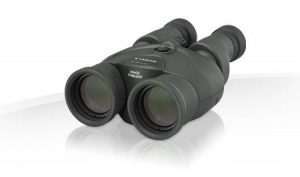 Canon was the first to put Image Stabilization (IS) into binoculars, mixing this amazing technology with high ocular quality.
Canon was the first to put Image Stabilization (IS) into binoculars, mixing this amazing technology with high ocular quality.
Several worthy IS brands now exist, and, of course, cheap knock-offs … but the original line is still a top contender.
Many users are taking a second look at older Canon favorites.
The Canon 12×36 IS III binoculars are a classic model still praised by seasoned users. We’ll take a look at what’s made these bins so popular, and why you might be interested.
Canon 12×36 IS III Review
[wpsm_box type=”dashed_border” float=”none” text_align=”left” width=”100%” ]
[wpsm_column size=”one-half”]
[/wpsm_column]
[wpsm_column size=”one-half” position=”last”]
[wpsm_list type=”check” hover=”1″ gap=”medium”]
- Vari-Angle Prism Image Stabilization
- Eco-Friendly Lead-Free Glass
- Super Spectra Multicoated Optics
- Doublet Field-Flattener Lenses
- Center Focus Wheel
[wpsm_button color=”blue” size=”medium” link=”https://www.amazon.com/dp/B00XOD5C1W/?tag=opticzoo-20″ icon=”none” class=”” border_radius=”0 px” target=”_blank” rel=”nofollow”]Check Price on Amazon![/wpsm_button]
[rehub_affbtn btn_text=”Check Price on B&H Photovideo!” btn_url=”https://bhpho.to/30wnzEI” target=”_blank” ]
[/wpsm_column]
[/wpsm_box]
First, the good stuff. As expected of a Canon 12×36 IS III model, the 12×36’s optical quality is excellent, and its impressive IS system takes magnification up a notch in the high-contrast detail you can see.
The bright, high-definition view has accurate color rendition and features edge-to-edge sharpness and clarity.
The 12×36’s are lightweight at less than a 1.5 lbs, and they’re water-resistant too — which is more than Canon gives most of its IS bins.
[wpsm_box type=”info” float=”none” text_align=”left”]
IS requires a modest sacrifice in image quality due to its “correction” process, but Canon has done a good job mitigating the loss.
[/wpsm_box]
There is minor chromatic aberration with occasional artifacts, but these become quibbles when you press the magic IS button.
Still a Classic
These were the only 12x Canon binoculars until the company introduced an updated “Shift method” group of IS bins in August of 2017. One of the new bins are 12x that have much the same performance but better close-focus range.
The new bins are heavier and cost more, and haven’t earned the appreciative fan base of their classic 12×36 IS model.
The promise Canon makes with its IS binoculars is to provide a startlingly good image with maximum convenience to the user … at a maximum price, too, but you knew that.
The 12×36 IS bins deliver on Canon’s promise with a lightweight, water-resistant glass that you simply put to your eye to enjoy a tripod-quality high-definition image.
[wpsm_column size=”one-half”][wpsm_pros title=”PROS:”]
- IS
- High-def optics
- Good low-light performance
- Lightweight
- Water-resistant
[/wpsm_pros][/wpsm_column][wpsm_column size=”one-half” position=”last”][wpsm_cons title=”CONS:”]
- Mild chromatic aberration
- Mediocre close-focus range (19 feet)
[/wpsm_cons][/wpsm_column]
Features
The features of Canon’s 12×36 IS III binoculars have made them long-time favorites, and add up to a well-balanced and versatile high-performance instrument.
12x Magnification
12x is not traditionally a high-demand magnification power for bins. It’s too shaky and narrow for targeting and too weak for astronomy … so, why?
The 12×36 answers in two ways: superior optics and stabilization. The 36mm objectives bring in good light, and the IS makes these bins a little more powerful than your regular field glass.
[wpsm_box type=”info” float=”none” text_align=”left”]
The IS lets you sweep the area at 12x without judders, and has enough optical quality to deliver clear images from farther and deeper.
[/wpsm_box]
High-Quality Optics
The high optical quality of these bins starts with finely-tuned Porro prism construction and optical coatings that keep light alive in the chamber.

Field-flatteners correct image curvature, contributing to the view’s consistent edge-to-edge quality. These elements elevate the 12x magnification to a stargazer’s instrument.
Image Stabilization
Introducing IS made Canon famous in binocular history, and the company established a high standard of optical quality right from the beginning.
The 12×36’s large IS button is placed conveniently on the barrel, and when you press it the magic begins. Stabilization is almost instant.

Swaying, blurred detail comes alive with precise, clear views. You follow moving objects much more easily, and watch them in flight.
This isn’t to say IS doesn’t come with a cost to the image. It costs some brightness, it makes it harder to prevent chromatic aberration. Canon works hard to overcome the obstacles — if you switch off the IS, you’ll see the image improve still more.
But the IS-enhanced picture is sharp as you can reasonably find on the market, and it has an advantage in bringing out fine detail.
Effect of IS in Canon Image Stabilizer Binoculars:
FOV & Low-Light Performance
We may as well get these two disappointment out of the way together. Both are about the limitations of the 36mm objectives.
The middling Apparent FOV of 55.3º means these bins struggle in a head to head against a genuine wide-eyed field glass. You can see the image better, which may be a consolation, but that’s for each buyer to decide.
[wpsm_box type=”warning” float=”none” text_align=”left”]
The low-light performance is also limited: these aren’t notable twilight bins, they’re just better than most IS binoculars. You get some extra help from the IS, but forget predawn birding raids and after-hour viewing.
[/wpsm_box]
Weatherproof Construction
The Canon 12×36 IS III is resistant to water and fogging, it’s not waterproof. Like many IS bins, they are unsealed against water. The resistance is enough to survive a light rain without fogging, but don’t get carried away.
The housing has a rather flimsy plastic feel, but that’s a feature of mass-market production: it’s actually fairly well built.
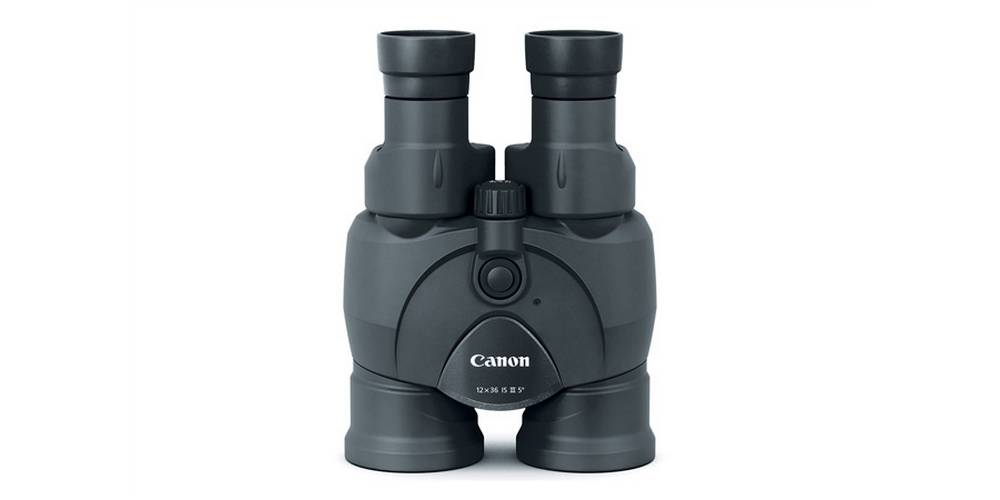
The case is covered by water-resistant rubber armor that offers a secure grip. The top coating can wear too quickly get sticky over time.
Comfort & Handling
At just under a pound and a half, these are light binoculars, especially for an IS model. You can bring them along on walks with a neckstrap without tiring, and they can be operated with one hand.
The large IS button is conveniently located in the center, just in front of the focus wheel. You press down to activate the IS, which saves battery power, but there isn’t a timer function … you have to press down constantly if you want IS.
The eye relief is a decent 14.5, so most users can view with the 12×36 without removing their eyeglasses. The fold-down eyecups are made of soft rubber, and are narrow enough to push on, as some users prefer.
[wpsm_box type=”info” float=”none” text_align=”left”]
Pro Tip: Always try out binoculars before buying! What fits great for one person can hobble another.
[/wpsm_box]
Access and service
Let me warn you, this section is short and not sweet. Canon doesn’t go overboard in welcoming you to their family of products, and complaints about it haven’t ever mattered.
They know we don’t buy their IS bins to get a hard carrying case, so they call our consumer bluff and dispense with extras.
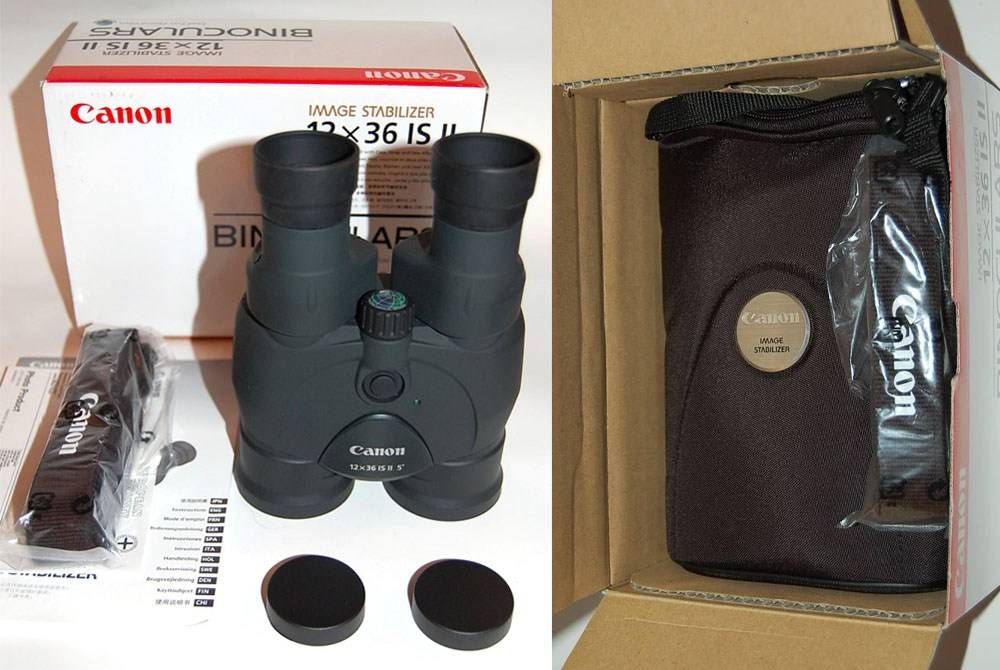
It’s pleasant to say these bins have nicely-fitting, convenient protective lens covers, but it’s impossible since Canon hasn’t supplied one at all. The highlight of the packaging is a neck strap: it isn’t widely reported as uncomfortable.
The service warranty is limited, and the electronics portion — the IS — has a much shorter period. Canon isn’t the worst multinational conglomerate corporate mass-market manufacturer in terms of customer support.
Alternatives
[wpsm_box type=”dashed_border” float=”none” text_align=”left” width=”100%” ]
1. Canon 12×32 IS Review
[wpsm_column size=”one-half”]
[/wpsm_column]
[wpsm_column size=”one-half” position=”last”]
[wpsm_list type=”check” hover=”1″ gap=”medium”]
- Lens-Shift Image Stabilization
- Field-Flattener Lens System
- Super Spectra Multi-Coated Optics
- Normal and Powered IS Modes
- Simple 2-Button User Interface
- Fold-Down Rubber Eyecups
[wpsm_button color=”blue” size=”medium” link=”https://www.amazon.com/dp/B07CRN8C8K/?tag=opticzoo-20″ icon=”none” class=”” border_radius=”0 px” target=”_blank” rel=”nofollow”]Check Price on Amazon![/wpsm_button]
[rehub_affbtn btn_text=”Check Price on B&H Photovideo!” btn_url=”https://bhpho.to/30rLvc9″ target=”_blank” ]
[/wpsm_column]
[/wpsm_box]
In 2017, Canon came out with new Canon 12×32 IS model … it uses “Shift” technology for stabilization to replace the Vari-angle Prism design of their older bins.
The newer 12x’s have a streamlined style and — a shout-out to birders — boasts a remarkable 6.6 ft./2.0m close-focus range, about 13 feet better than our 12×36 classic.
You lose water-resistance though, and the price is higher for the newer 12×32’s — and they’re about 4 oz heavier.
The updated model is appealing for birders, or if you prefer owning the latest gear, but they aren’t giving them away.
This is likely an interim series on the way to a new breed of IS bins. The performance is basically the same optically as the older version, while using smaller 32mm objectives.
They use an identical chassis across this family line-up, which is easier for the manufacturer, but not necessarily optimal for the customers.
[wpsm_column size=”one-half”][wpsm_pros title=”PROS:”]
- Sharp, clear image comparable to the older 12×36 model
- Improved close-focus range
[/wpsm_pros][/wpsm_column][wpsm_column size=”one-half” position=”last”][wpsm_cons title=”CONS:”]
- Lacks even the water-resistance of the older 12×36
- 4 oz heavier
- Inferior in low-light conditions
[/wpsm_cons][/wpsm_column]
See them online!
[wpsm_box type=”dashed_border” float=”none” text_align=”left” width=”100%” ]
2. Canon 15×50 IS Review
[wpsm_column size=”one-half”]
[/wpsm_column]
[wpsm_column size=”one-half” position=”last”]
[wpsm_list type=”check” hover=”1″ gap=”medium”]
- Electronic Image Stabilization
- Ultra-Low Dispersion Lead-Free Glass
- Porro Prism Optical Path
- Fully Super Spectra Coatings
- Large Center Focusing Knob
- Fold-Down Rubber Eyecups
[wpsm_button color=”blue” size=”medium” link=”https://www.amazon.com/dp/B00006I53P/?tag=opticzoo-20″ icon=”none” class=”” border_radius=”0 px” target=”_blank” rel=”nofollow”]Check Price on Amazon![/wpsm_button]
[rehub_affbtn btn_text=”Check Price on B&H Photovideo!” btn_url=”https://bhpho.to/30siZrd” target=”_blank” ]
[/wpsm_column]
[/wpsm_box]
If you’re interested in the next step up in magnification and durability, the 15x is another Canon classic to check out.
Canon 15×50 IS has a similar “balanced” synergy of features that make it especially useful as the older 12×36.
It is pricier than our 12x model, but Canon 15×50 IS bins are All-Weather. They’re almost twice the weight at 41.6 oz vs. 23.3 oz.
You lose some FOV compared to the 12×36, but the exit pupil is larger at 3.3mm and the eye relief longer at 15mm.
There probably isn’t another 15x mag bino that can be so easily viewed handheld, as most models require mounting at this power.
[wpsm_column size=”one-half”][wpsm_pros title=”PROS:”]
- Superior magnication
- Same quality IS
- All-Weather
[/wpsm_pros][/wpsm_column][wpsm_column size=”one-half” position=”last”][wpsm_cons title=”CONS:”]
- Heavier than 12×36
[/wpsm_cons][/wpsm_column]
Check it out online!
[wpsm_box type=”dashed_border” float=”none” text_align=”left” width=”100%” ]
3. Fujifilm Techno-Stabi TS12x28 Review
[wpsm_column size=”one-half”]
[/wpsm_column]
[wpsm_column size=”one-half” position=”last”]
[wpsm_list type=”check” hover=”1″ gap=”medium”]
- ±3° Stabilization
- Phase-Corrected Prisms
- Fully Multi-Coated Lenses
- Auto Shutoff After 10 Minutes Inactivity
- Twist-Up Eyecups
- Up to 12 Hours Runtime
[wpsm_button color=”blue” size=”medium” link=”https://www.amazon.com/dp/B0798BBL9Y/?tag=opticzoo-20″ icon=”none” class=”” border_radius=”0 px” target=”_blank” rel=”nofollow”]Check Price on Amazon![/wpsm_button]
[rehub_affbtn btn_text=”Check Price on B&H Photovideo!” btn_url=”https://bhpho.to/30woYes” target=”_blank” ]
[/wpsm_column]
[/wpsm_box]
You might want to check out another lightweight 12x bin with IS: the Fujinon from Fujifilm, a newer brand that’s gained a following.
They use a strong IS that can handle bumpier conditions than the 12×36 can.
Fujifilm Techno-Stabi TS12x28 lets through some smaller tremors, however, which a Canon can handle as an everyday job.
These Fujinon’s are especially recommended for boating, where they outperform Canon. The optics aren’t as good as Canon’s — few IS bins are. They need good light to operate, too. No twilight bins these.
They have even less ruggedness than the water-resistant 12×36, which is a downer considering the price point.
Fujinon gets only an IPX-2 weatherproofing rating, which gives you 10 minutes of protection against dripping water. Not great at this price point, but our 12×36 hero is only a little more protected.
[wpsm_column size=”one-half”][wpsm_pros title=”PROS:”]
- Strong IS stabilization good for boating
- Compact size
[/wpsm_pros][/wpsm_column][wpsm_column size=”one-half” position=”last”][wpsm_cons title=”CONS:”]
- Poor low-light performance
- Lack of water-resistance
[/wpsm_cons][/wpsm_column]
Check them out online!
Conclusion
Canon’s line of IS binoculars are all originals, and a few have become classics. The Canon 12×36 IS III have been popular since their release.
Like all their binoculars, these lightweight bins are made for a minimalist experience of simple handheld viewing.
The IS makes their 12×36 more versatile as a field glass, because it removes the shakiness inherent in the higher mag. You don’t need a tripod for celestial gazing, either.
This old favorite isn’t perfect. You have to hold down a button for IS, and these are not durable enough for inclement weather. It’s about the image and convenience, and both are here for the money.
The Canon 12×36 IS III is a nice balance of features, and they’re still worth a look.
Check they out for yourself.
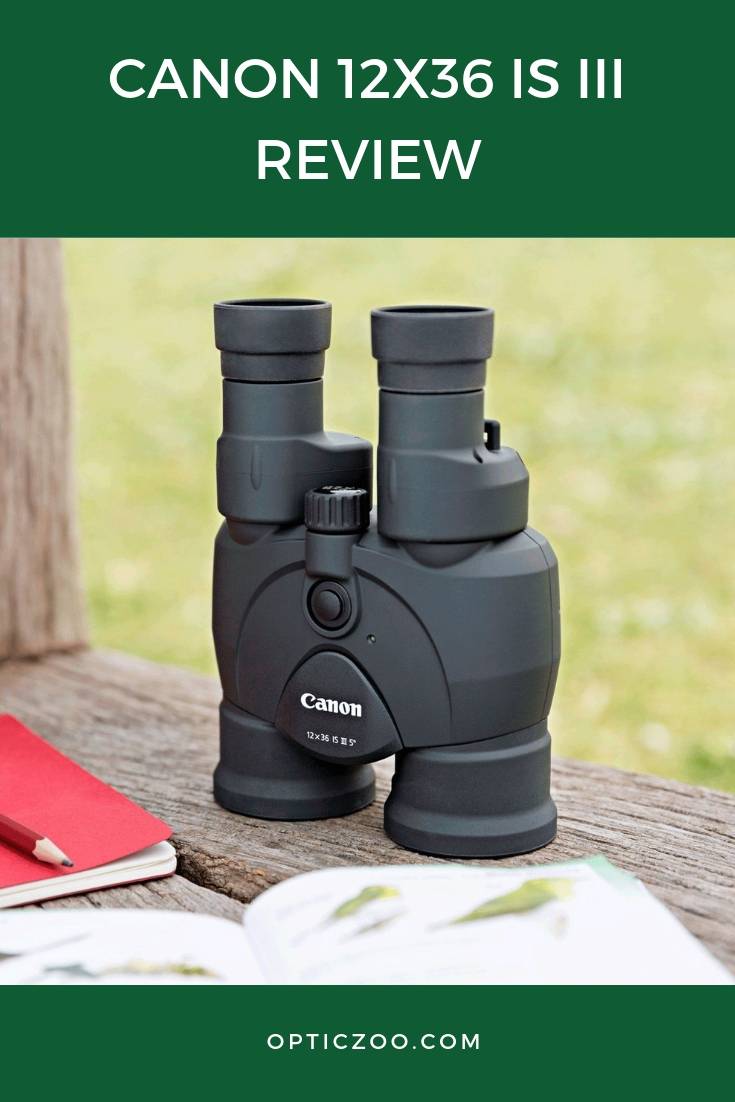

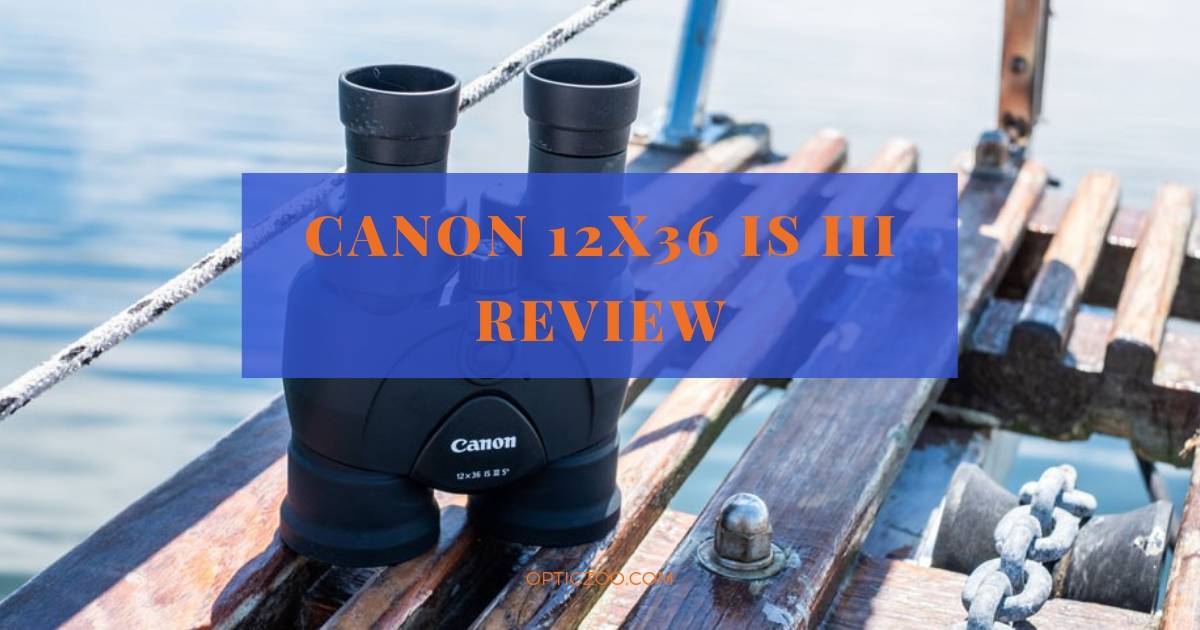

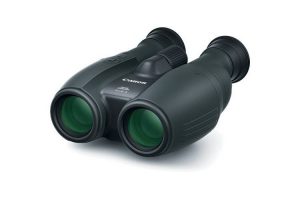
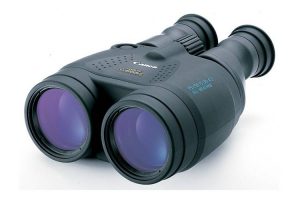
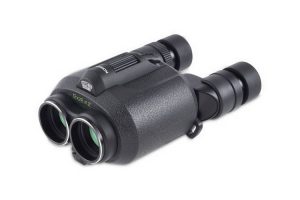
Dear All
I purchased the Canon 12×36 IS III last week while passing through Tokyo Narita Airport for US$906.
I live at Lennox Head NSW which is a coastal town.
If I need to clean any optics of sea salt or spots of sand I use an optics pump spray to dissolve the salt and lift any sand grit then gently clean with an appropriate cloth. That has always worked well.
UNDER NO CIRCUMSTANCES DO THIS EVER !!! YOU WILL DESTROY YOUR BINOCULARS AND LOSE YOUR 906 DOLLARS.
These binoculars cannot tolerate any liquid contact. The fluid leaks around the edges of the unsealed lenses and gets on the back of the lens and the prisms. MY BINOCULARS ARE NOW TOTALLY USELESS AND ONLY GOOD FOR THE RUBBISH BIN.
One splash of ocean wave and you will have ruined your binoculars.
THEY CAN ONLY BE CLEANED COMPLETELY DRY.
These binoculars are completely unsuitable for everyday use.
I shall do a youtube video next week to warn people not to buy these types of binoculars.
Hi Stephan.
I’m very sad to hear that. But thank’s for your advice!
Thank you for the heads up on this. I would be pretty angry too if this happened to me. Reviews all say water resistant, sure does not sound like it. Did you try using a desiccant to pull the water out of the binoculars? Put a bag of rice in a gallon ziploc bag, lay paper towel over the rice, then place the binoculars on the paper towel and zip it closed. Carefully set aside and wait a couple of weeks. If that doesn’t work it may need more time. Repeat as needed. It works for cell phones, give it shot. If you are fed up with the product, dry it out and gift it to someone. Don’t forget to tell them why you are upset with the product so they take the proper precautions.
I purchased the previous version of these only to have the soft rubber ‘melt’ after about 7 years. Its a known defect that Canon have been denying exists, but if you Google it you will see it is a disaster. These were well looked after and spent 99.9 percent of their life in a case.